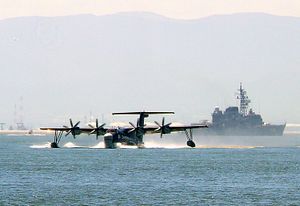Japanese Prime Minister Shinzo Abe’s visit to India as chief guest at its Republic Day celebrations yielded some important advances in India-Japan relations. Notably on the security front, the two resolved to consult on national security matters between their two national security apparatuses (Japan’s national security council having been formed recently). Additionally, the two will conduct a bilateral naval exercise in the Pacific Ocean in a move that is sure to draw China’s attention. The pending sale of the ShinMaywa US-2 amphibious patrol aircraft–a topic of interest for India since 2011–also inched forward. Abe and Prime Minister Manmohan Singh agreed that India and Japan would follow up on the sale in March with a joint working group meeting. Indian Defense Minister A.K. Antony is set to visit Japan at some point this year (presumably before May, due to the general elections in India) to finalize the deal.
The deal is significant for a variety of reasons. On the surface, it’s another indicator of burgeoning cooperation between India and Japan on security matters. The deal is doubly significant in the context of India’s relations with Japan because once India clinches the deal, it will become the first country to purchase defense equipment from Japan since the latter’s self-imposed ban on defense exports began in 1967. The deal is important for Abe as it would open up Japan’s defense industry for additional contracts with foreign partners and stimulate Japan’s defense industry. It should be noted that negotiations on the US-2 deal began in 2011 under the Democratic Party of Japan, first under Prime Minister Naoto Kan and then under Yoshihiko Noda.
According to Reuters, the US-2 deal could result in a $1.65 billion tab for India, which is looking at purchasing 15 of the amphibious patrol aircraft. The deal is essentially a fait accompli (cleared politically at the highest levels in both countries) and the joint working group will iron out certain details including important modifications that would allow Japan to export the aircraft to India without violating its self-imposed defense export restrictions. A Reuters report notes that the modifications will include the removal of a friend or foe identification system. Another point of discussion for the two sides is whether India will be permitted to assemble the aircraft indigenously, giving it access to Japanese military technology.
Strategically, the US-2 is important for India beyond its relationship with Japan. The US-2 has a more than modest range of 4,500 km and India’s 15 aircraft will be stationed in the Andaman and Nicobar Islands, in the Bay of Bengal. The US-2 is a versatile aircraft for search and rescue operations as well, partly owing to its short take-off ability. According to an anonymous Indian military source interviewed by Reuters, the US-2 will allow India to support military and civilian ships deep in Southeast Asian waters. The military source notes: “You are sailing further and further away, and ships break down at sea. You can either wait for reinforcements to arrive by sea or bring in an amphibian right next to the stricken ship.” Procurement of the US-2 additionally directly counters Indian fears of China’s burgeoning “string of pearls” strategy in Southeast Asia.
Overall, expect a India-Japan US-2 deal in the near future–possibly before India’s general elections. The US-2 deal will serve as a gateway for India and Japan to explore additional cooperation on defense technology. The joint statement coming out of Abe’s visit to New Delhi last weekend noted that India and Japan are seeking to cooperate on advanced technologies more generally. Prospects for increased defense cooperation remain positive as long as Shinzo Abe remains at the helm in Tokyo; revising Japan’s guidelines on defense technology exports is a strategic priority for Abe and the man happens to be quite the Indophile.
A looming consequence of the US-2 deal will be increased Chinese skepticism that the strategic convergence between India and Japan is anything other than a bulwark against China’s ambitions along the Asia-Pacific rimland. Additionally, the deal would in essence move Japan more in the direction of military normalization; allowing Japan to export its defense know-how and technology freely across Asia could prove deleterious to China’s interests.
For the moment, Indian and Japanese diplomats and leaders remain careful to omit any mention of China during their bilateral meetings. So far, all bilateral military exercises between India and Japan have occurred under the premise of promoting freedom of navigation in Asia’s crowded sea lanes and combating piracy. A day may come when New Delhi begins to back Tokyo in its disputes with Beijing and Tokyo returns the favor, but a variety of political factors still inhibit that sort of openness in this important bilateral relationship between Asia’s largest and richest democracy. A US-2 deal won’t supercharge the positive momentum in the India-Japan relationship, but it won’t hurt either.

































